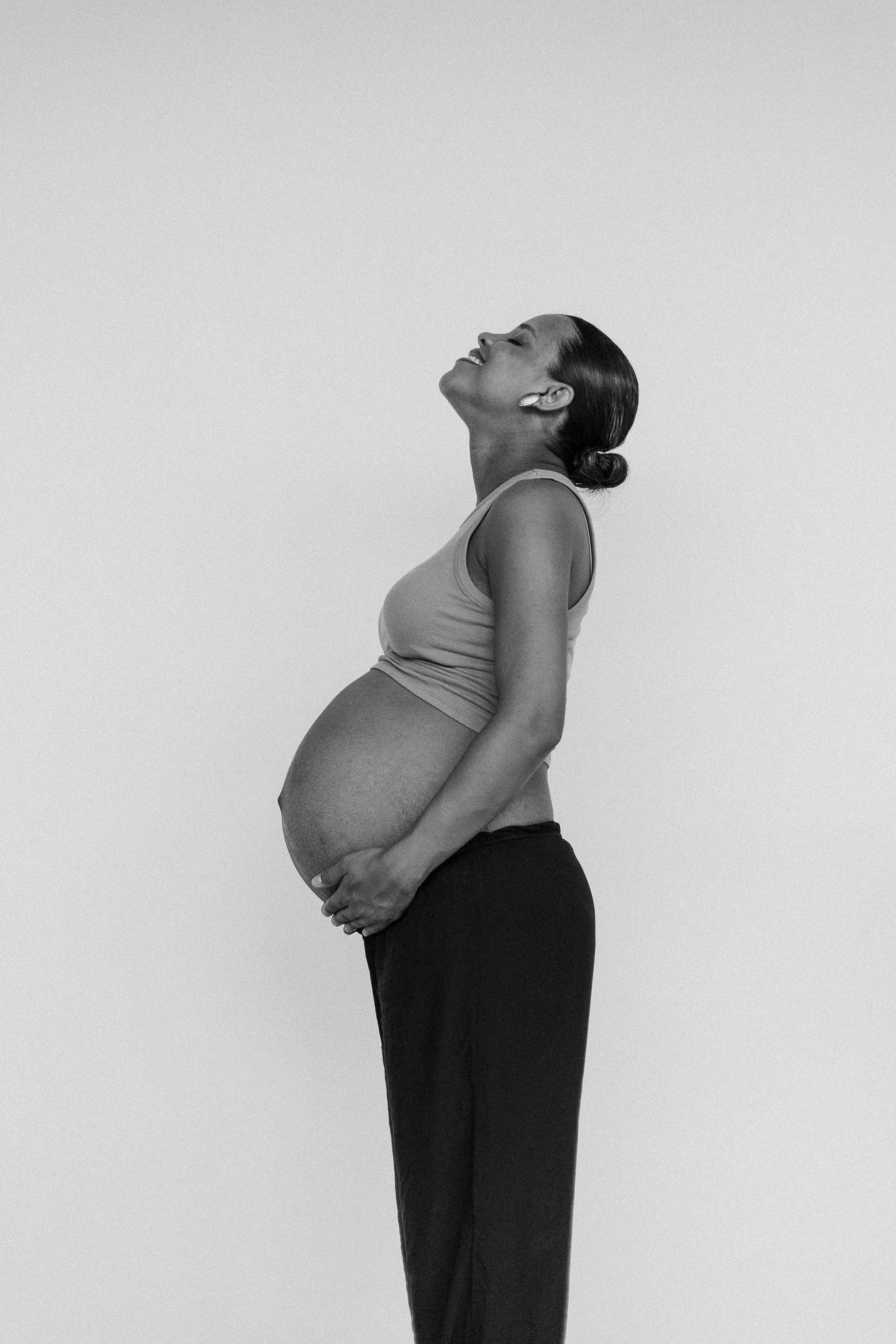
Awakening
the first trimester
In the quiet beginnings, life stirs unseen, like a seed pressing through dark soil. The first trimester is a time of mystery and surrender, when the body whispers of change and the soul softens to receive. Within the hidden chambers of your womb, a spark of light takes root, drawing nourishment from both earth and spirit. This season invites trust — a leaning into the unseen, a faith that what is growing, though invisible, is sacred and sure.
Foundations for this Season
A gentle guide to nurturing yourself and your baby through the first 12 weeks of pregnancy.
Vitamins
Nutrition
Rest
What to expect in your first trimester
The first trimester (weeks 1–13) is often the biggest adjustment period for a first-time mom — your body is quietly working overtime, even if you don’t “look” pregnant yet.
It’s okay if you feel unlike yourself; your body is already mothering, reshaping, and growing in profound ways.
In the span of just twelve weeks, pregnancy works a quiet miracle.
For baby, this is a time of breathtaking transformation — from a microscopic cluster of cells to a tiny, fully formed fetus with a beating heart by week six and all major organs present by week twelve. Little features like eyes, ears, and fingers begin to take shape, and subtle movements stir within the womb.
For mama, the first trimester often feels like a season of surrender. Hormones surge — progesterone, hCG, estrogen — bringing waves of fatigue, nausea, food aversions, and mood shifts. Physical changes like breast tenderness, bloating, and frequent trips to the bathroom mix with emotions of wonder, vulnerability, and excitement.
Behind the scenes, the body is quietly prioritizing nutrients like folate, iron, and hydration as the placenta forms and blood volume expands. It is a time to honor rest and gentle care, trusting that your body is already working harder than it ever has before.
From nausea to mood swings, here’s what might show up.
Every mama’s body responds differently, and the kind of support that feels right for one person may not resonate for another. Some women breeze through the first trimester with only mild fatigue, while others find themselves navigating waves of nausea, tender breasts, or overwhelming tiredness.
While no two journeys look the same, the common threads of the first trimester is that your body is working incredibly hard, often in ways you can’t see. The best thing you can do is listen closely to your own body and honor what you need, trust what your body asks for, and remember there’s no one “right” way to move through this season.
-
What’s Happening
Rising hCG and estrogen mess with your stomach and sense of smell. Despite the name, nausea can strike at any time of day.
How to Prepare
Keep bland snacks (crackers, pretzels, dry toast) nearby, especially by your bed. Ginger tea, chews, or peppermint tea may soothe the stomach. Small, frequent meals are easier than large ones. If severe nausea prevents you from keeping fluids down, talk with your doctor — safe prescription options exist. -
What’s Happening
Progesterone rises sharply, blood volume increases, and your body begins building the placenta — all of which drain energy.
How to Prepare
Prioritize rest with naps or earlier bedtimes. Light movement like walking or stretching can boost energy. Stay hydrated and lower your schedule expectations where possible. -
What’s Happening
Hormonal changes prepare milk ducts for feeding, causing tenderness, swelling, and sensitivity.
How to Prepare
Switch to soft, supportive bras or bralettes. Warm compresses or cool packs may ease soreness. Natural lotions or oils can keep skin comfortable as it stretches. -
What’s Happening
Progesterone slows digestion to maximize nutrient absorption for baby. This can cause bloating, constipation, and gas.
How to Prepare
Stay hydrated, eat fiber-rich foods (fruit, veggies, oats), and move gently after meals. Magnesium-rich snacks like pumpkin seeds or leafy greens can support digestion. -
What’s Happening
Hormonal surges, fatigue, and the emotional weight of early pregnancy can lead to irritability, tears, or heightened sensitivity.
How to Prepare
Normalize the ups and downs. Journaling, meditation, or talking openly with trusted friends or a therapist can help. Remind yourself: big feelings are part of big changes.
First Trimester Timeline
-
Weeks 1–4: The Secret Beginning
Conception happens, cells multiply, and the tiny blastocyst implants in the uterus. The placenta begins to form.
Mama’s hormones shift dramatically. Fatigue may sneak in, but many women don’t feel pregnant yet.

-
Weeks 5–6: The First Beat
Baby’s heart begins to beat. Tiny buds for arms and legs appear, and the neural tube closes, forming the foundation of the brain and spine.
Mama may notice morning sickness, food aversions, and tender breasts. Frequent urination often begins as the body adjusts.

-
Weeks 7–8: Foundations Forming
Baby’s major organs begin developing — brain, liver, and kidneys — while eyes, nose, and ears start to take shape.
Mama may feel nausea peak, with energy dipping lower. Heightened sense of smell and emotional swings are common.

-
Weeks 9–10: The Little Human
Baby transitions from embryo to fetus. Fingers and toes separate, tooth buds appear, and bones begin to harden.
Mama might experience bloating, constipation, or mood shifts. Dreams can become vivid, and the reality of pregnancy feels more present.

-
Weeks 11–12: Blossoming
All major organs are now formed. Baby measures about 2 inches and begins small movements, though mama can’t feel them yet.
Mama may notice nausea easing and the start of a small belly curve. This is often the stage of the first ultrasound.

-
Week 13: Transition
Baby develops vocal cords, and intestines move into the abdomen. Baby is now about the size of a plum, complete with unique fingerprints.
Mama may feel her energy returning and appetite increasing. It’s the gentle doorway into the second trimester glow.

First Trimester — Appointments & Testing
Laying the foundation for your pregnancy care
Initial Prenatal Visit (around 8–10 weeks):
Confirms your pregnancy and estimated due date (often via Ultrasound).
Reviews your health history, medications, and lifestyle.
Includes baseline bloodwork and Urinalysis to check blood type, iron, thyroid, immunity, infections, and more.
Optional Early Screening Tests (weeks 10–13):
NIPT (Non-Invasive Prenatal Testing) — screens baby’s DNA for chromosomal conditions.
Nuchal translucency scan — ultrasound measuring fluid behind baby’s neck, often done with bloodwork.
What to Know:
This is the most comprehensive appointment of your pregnancy — expect it to run longer. It’s a great time to ask any questions about symptoms, vitamins, and what to expect.
What to avoid during pregnancy?
Pregnancy isn’t about restriction—it’s about creating the safest, most nourishing space for you and your baby. Think of these “avoids” as acts of love, protecting your little one while you focus on what you can enjoy: wholesome foods, gentle movement, rest, and meaningful connection.
-
Alcohol
There’s no safe amount of alcohol during pregnancy. Even small amounts can affect your baby’s developing brain and increase the risk of birth defects.
Undercooked Meats, Fish & Eggs
These foods can carry harmful bacteria or parasites, which may cause infections that are especially risky during pregnancy. Always cook meat, fish, and eggs thoroughly.
High-Mercury Fish
Certain large fish — like shark, swordfish, king mackerel, and tilefish — are high in mercury, which can harm your baby’s developing brain and nervous system. Choose low-mercury fish like salmon, sardines, or trout instead.
Unpasteurized Dairy & Juices
Can carry listeria or harmful bacteria. Always choose pasteurized products.
Deli Meats & Hot Dogs
Risk of listeria contamination if eaten cold. Only safe if heated until steaming hot.
Raw Sprouts
Alfalfa, clover, and mung sprouts can easily harbor bacteria. Cook thoroughly or skip for now.
Excess Caffeine
Limit to about 200 mg/day (around one 12 oz cup of coffee). Higher amounts can raise risk of miscarriage or low birth weight.
Certain Herbal Teas
Some herbs may not be safe in pregnancy (like licorice root, pennyroyal, or sage). Always check individual ingredients.
Aspartame
A common artificial sweetener in diet sodas, sugar-free gums, and packaged foods. Excessive intake has been questioned for potential effects on fetal development. Limit or avoid artificial sweeteners during pregnancy and choose naturally sweet options like fruit, honey, or maple syrup when possible.
-
Smoking & Recreational Drugs
Smoking, vaping, cannabis, and other recreational drugs are strongly linked to preterm birth, low birth weight, and complications. There is no known safe amount.
Pain Relievers
(Ibuprofen, Aspirin, Naproxen)
These non-steroidal anti-inflammatory drugs (NSAIDs) can cause complications in pregnancy, especially in the third trimester, including heart and kidney issues in baby. Use only if specifically prescribed by your provider.
Certain Prescription Medications
Some prescription drugs may be unsafe or need dose adjustments during pregnancy. Always check with your provider before continuing or stopping any medications.
High-Dose Adaptogens & Nootropics
Popular supplements like Ashwagandha, Maca, or medicinal mushrooms often affect hormones or the nervous systemand lack safety data in pregnancy. It’s safest to pause these until postpartum unless cleared by your provider.
Vaccines
Live vaccines such as the MMR (measles, mumps, rubella) or Varicella (chickenpox) are not safe during pregnancy. Always talk to your provider about timing and what’s right for you.
-
Hot Tubs, Saunas & Very Hot Baths
High body temperatures in early pregnancy can increase the risk of neural tube defects and may also cause dizziness or dehydration.
Red Light Therapy
Red and near-infrared light therapy devices can raise core body temperature and affect cellular activity, but their safety in pregnancy hasn’t been studied. It’s best to pause red light or infrared treatments until after birth.
Cryotherapy
Extreme cold exposure can constrict blood vessels, alter circulation, and trigger stress responses that may not be safe during pregnancy.
Skip whole-body cryotherapy chambers and intense cold plunges — gentle cool showers or brief swims are safer ways to refresh.Heavy Lifting & High-Impact Activities
Lifting very heavy objects or doing high-impact sports with a fall risk (like skiing, horseback riding, or contact sports) can strain your body and increase injury risk. Opt for lower-impact exercise, use proper form, and ask for help lifting heavier items.
Harsh Cleaning Chemicals & Paint Fumes
Certain chemicals and strong fumes can be irritating or harmful during pregnancy. Use natural or non-toxic cleaners when possible, wear gloves, and ensure good ventilation when painting or cleaning.
Pesticides & Herbicides
Pesticides and herbicides used on crops and lawns can contain chemicals linked to developmental and neurological concerns in babies.
Whenever possible, choose organic produce, wash fruits and vegetables thoroughly, and avoid applying lawn or garden chemicals during pregnancy.Fluoride
While fluoride is widely used to protect teeth, some studies have suggested a possible link between high prenatal fluoride exposure and later attention issues such as ADHD.
Cat Litter
Cat feces can carry Toxoplasmosis, which can harm your baby. Have someone else scoop the litter if possible. If you must do it, wear gloves and wash your hands thoroughly afterward.
-
Retinol & Retinoids
(Vitamin A Creams, Accutane)
Topical and oral retinoids (vitamin A derivatives) can cause serious birth defects. Avoid prescription acne treatments like Accutane and skincare products with retinol or retin-A.
High-Dose Salicylic Acid
High oral doses or concentrated chemical peels are unsafe during pregnancy. Small amounts in over-the-counter topical products (like face washes or spot treatments) are generally considered safe — though it’s best to minimize use if you can.
Unregulated Essential Oils
Certain essential oils — such as Clary sage and Pennyroyal — can trigger contractions or be unsafe during pregnancy. Use only pregnancy-safe oils and always check with your provider or a certified aromatherapist first.
Nail & Hair Treatments
Some nail polishes, hardeners, or keratin hair treatments can release formaldehyde fumes, which are best avoided in pregnancy. Skip these or choose non-toxic, pregnancy-safe salon products.
Shopping Guide
First Trimester : Soothing the Shifts
High-Quality Prenatal Vitamins
Support your baby’s earliest development with a prenatal that includes folate, iron, iodine, choline, omega-3s and vitamin D — building the foundation from the very beginning. You can also supplement with additional vitamins where needed.
Morning Sickness Soothers
Ease queasiness with gentle remedies like ginger chews, peppermint tea, or sparkling water — small comforts that make a big difference.
Hydration Support
Electrolyte drinks (or coconut water) can also be incredibly helpful if nausea or vomiting makes staying hydrated harder. Replenishing lost minerals helps prevent dizziness, headaches, and fatigue — and can keep your energy steadier throughout the day.
Stretchy Clothing & Cozy Bralettes
Light, stretchy pieces help you feel at ease as early bloating and body shifts begin — comfort over structure is key right now.
Tender breasts call for soft, wireless support. Bralettes keep you comfortable as your body begins to change.
Simple Snacks
Keep nourishing, easy-to-grab snacks on hand to stabilize blood sugar and soothe nausea throughout the day. Try foods with protein, fiber, and healthy fats to keep you steady — like nuts, seeds, fresh fruit, dried fruit, whole-grain crackers, cheese sticks, Greek yogurt, or hummus with veggies.
Pregnancy Journal & Keepsake Book
Capture the quiet beginnings of your journey — your hopes, symptoms, milestones, and memories as your baby’s story starts to unfold.
Consider choosing a guided pregnancy journal that includes space for ultrasound photos, bump pictures, and notes about cravings, feelings, and milestones. One day, you can pass it on to your baby as a keepsake — a love letter from the time they were still growing inside you.






